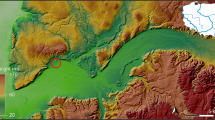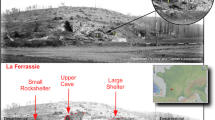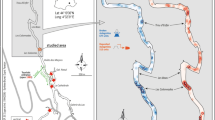Abstract
Southwest Ethiopia’s cool, moist, and steep highlands differ from other African environments, and may have fostered distinct patterns of Holocene resource use and intensification. Prior to 2004, only a few archaeological projects probed eastern and northern margins of this region. The Kafa Archaeological Project (2004–2006) excavated ten caves and rockshelters in different environments in the heart of southwest Ethiopia to obtain a Holocene chronology and compare it with adjacent regions. At Kumali Rockshelter, middle Holocene deposits show use of a microlithic industry to obtain wild game, and excellent macrobotanical preservation promises to reveal changes in plant use from 4,700 14C bp to the present. Ceramics and domestic animals appear at Kumali and Koka by ~2,000 14C bp, suggesting herding and pottery making appeared late and contacts with neighboring regions were tenuous. Technologically conservative people continued microlith production and sporadic rockshelter use into the eighteenth century CE.
Résumé
Le haut plateau escarpé au climat frais et humide du Sud-ouest de l’Éthiopie se distingue des autres environnements africains et a favorisé des schémas variés d’utilisation et d’intensification des ressources Holocènes. Avant 2004, seuls quelques projets archéologiques ont exploré les bords nord et est de cette région. Le Kafa Archaeological Project (2004–2006) a fouillé dix grottes et abris sous roche, situés dans des environnements divers au milieu de cette région pour obtenir une chronologie holocène et la comparer aux régions voisines. Dans l’abri de Kumali, les dépôts de l’Holocène Moyen montrent l’utilisation d’une industrie microlithique pour la chasse, et la très bonne conservation des restes macrobotaniques promet de mettre en évidence des changements dans l’utilisation des plantes entre 4,700 14C bp et aujourd’hui. Céramiques et animaux domestiques apparaissent à Kumali et à Koka vers 2,000 14C bp suggérant une appearance tardive de la poterie et de l’élevage et peu de contacts avec les régions voisines. Les populations locals, marquées par une forte inertie technologique, ont continué à faire des outils microlithiques et utiliser sporadiquement les abris sous roche jusqu’à la 18ième siècle de notre ère.









Similar content being viewed by others
Notes
All dates are uncalibrated unless otherwise specified as calendar years BCE or CE.
References
Ambrose, S. H. (1984). Excavations at Deloraine, Rongai, 1978. Azania, 20, 29–67.
Anfray, F. (1968). Aspects de l’archéologie Éthiopienne. Journal of African History, 9, 345–366.
Azais, R., & Chambard, R. (1931). Cinq années de recherches archéologiques en Éthiopie. Paris: Geuthner, Paris.
Azmaye, A. (2007). Mosaic cultures & peoples of Southern Nations, Nationalities & Peoples’ Regional State. Awassa: SNNPRS Bureau of Information and Culture.
Bachechi, L. (2005). Preliminary report on the 2002 excavation of the Harurona cave deposit. In C. Cavanna, (Ed.), Wolayta: Una regione d’Etiopia. Atti Del Museo di Storia Naturale Della Maremma Supplemento, 21, 67–78.
Bard, K. A., Fattovich, R., Manzo, A., & Perlingieri, C. (1997). Archaeological investigations at Bieta Giyorgis (Aksum), Ethiopia: 1993–1995 field seasons. Journal of Field Archaeology, 24, 387–403.
Barthelme, J. W. (1985). Fisher-hunters and Neolithic pastoralists in East Turkana, Kenya. Oxford: British Archaeological Reports International Series 254.
Brandt, S. A. (1980). Archaeological investigations at Lake Besaka. In R. E. Leakey & B. A. Ogot (Eds.), Proceedings for the eighth Panafrican congress of prehistory and quaternary studies (pp. 239–243). Nairobi: International Louis Leakey Memorial Institute for African Prehistory.
Brandt, S. A. (1982). A late quaternary cultural/environmental sequence from Lake Besaka, Southern Afar, Ethiopia. Berkeley: Unpublished Ph.D. Thesis, University of California.
Brandt, S. A. (1984). New perspectives on the origins of food production in Ethiopia. In J. D. Clark & S. A. Brandt (Eds.), From hunters to farmers: the causes and consequences of early food production in Africa (pp. 173–190). Berkeley: University of California Press.
Brandt, S. A. (1986). The upper Pleistocene and early Holocene prehistory of the Horn of Africa. African Archaeological Review, 4, 41–82.
Brandt, S. A. (1988). Early Holocene mortuary practices and hunter-gatherer adaptations in southern Somalia. World Archaeology, 20, 40–56.
Brandt, S. A. (1996a). A model for the origins and evolution of Ensete food production. In T. Abate, C. Hiebsch, S. Brandt, & S. Gebremariam (Eds.), Ensete-based sustainable agriculture in Ethiopia (pp. 36–46). Addis Ababa: Institute for Agricultural Research.
Brandt, S. A. (1996b). The ethnoarchaeology of flaked stone tool use in southern Ethiopia. In G. Pwiti & R. Soper (Eds.), Aspects of African archaeology (pp. 733–788). Harare: University of Zimbabwe Press.
Brandt, S.A. (2000). Emergency archaeological fieldwork and capacity building at the Gilgel Gibe Hydroelectric Project, Deneba, Southern Ethiopia: Final Summary Report to the Ethiopian Tourism Commission and the Center for Research and Conservation of Cultural Heritage, Addis Ababa
Brandt, S. A., & Carder, N. (1987). Pastoral rock art in the Horn of Africa: Making sense of udder chaos. World Archaeology, 19, 194–213.
Brandt, S. A., Manzo, A., & Perlingueti, C. (2008). Linking the highlands and lowlands: Implications of a test excavation at Kokan Rockshelter, Agordat, Eritrea. In P. R. Schmidt, M. C. Curtis, & Z. Teka (Eds.), The archaeology of ancient Eritrea (pp. 33–47). Trenton: Red Sea Press.
Cauliez, J., Gutherz, X., & Pène, J.-M. (2008). First characterization of the Neolithic ceramic facies in the Gobaad region (Republic of Djibouti): The sites of Hara-Idé 2 and Asa-Koma (As-Eyla, District of Dikhil). L’Anthropologie, 112, 691–715.
Clark, J. D., & Stemler, A. B. (1975). Early domesticated sorghum from Central Sudan. Nature, 254, 588–591.
Clark, J.D. and Williams, M. (1978). Recent archaeological research in SE Ethiopia: Some preliminary results. Annales d’Éthiopie, XI, 19–44.
Close, A. (1995). Few and far between: Early ceramics in North Africa. In W. K. Barnett & J. W. Hoopes (Eds.), The emergence of pottery: Technology and innovation in ancient societies (pp. 23–37). Washington DC: Smithsonian.
Dale, D. (2000). Recent archaeological investigation of Kansyore sites in western Kenya. Azania, XXXV, 204–207.
D’Andrea, A. C. (2008). T’ef (Eragrostis tef) in ancient agricultural systems of highland Ethiopia. Economic Botany, 92(4), 547–566.
D’Andrea, A. C., Manzo, A., Harrower, M., & Hawkins, A. (2008). The Pre-Aksumite and Aksumite settlement of NE Tigrai, Ethiopia. Journal of Field Archaeology, 33, 151–176.
Dombrowski, J. (1970). Preliminary report on excavations in Lalibela and Natchabiet Caves, Begemeder. Annales d’Ethiopie, 8, 21–29.
Dombrowski, J. (1971). Excavations in Ethiopia: Lalibela and Natchebiet Caves, Begemder Province. Unpublished Ph.D. Thesis, Boston University.
Fattovich, R. (1990). The peopling of the northern Ethiopian-Sudanese borderland between 7000 and 1000 b.p.: A preliminary model. Nubica, I/II, 3–46.
Fattovich, R., & Bard, K. A. (1998). The archaeological expedition in Ethiopia (Aksum) of the Istituto Universitario Orientale and Boston University. Addis Ababa: Documentary Exhibition, Italian Cultural Institute.
Fernández, V., de la Torre, I., Luque, L., González-Ruibal, A., & López Sáez, J. (2007). A Late Stone Age sequence from west Ethiopia: The sites of K’aaba and Bel K’urkumu (Assosa, Benishangul-Gumuz Regional State). Journal of African Archaeology, 5(1), 91–126.
Finneran, N. (2000). Excavations at the Late Stone Age Site of Baahti Nebait, Aksum, Northern Ethiopia, 1997. Azania, XXXV, 53–73.
Finneran, N. (2007). The archaeology of Ethiopia. New York: Routledge.
Fuller, D. Q. (2004). Early Kushite agriculture: Archaeobotanical evidence from Kawa. Sudan & Nubia, 8, 70–74.
Guérin, C., & Faure, M. (1996). Chasse au chacal et domestication du boeuf dans le site néolithique d’Asa-Koma (République de Djibouti). Journal des Africanistes, 66, 299–311.
Gutherz, X., Lesur, J., Pouzolles, G., & Soroillet, D. (2002). Les fouilles de l’abri sous-roche de Moche Borago (Soddo, Wolayta): Premier bilan. Annales d’Éthiopie, XVIII, 181–190.
Harlan, J. R. (1969). Ethiopia: A center of diversity. Economic Botany, 23(4), 309–314.
Hildebrand, E.A. (2003a). Enset, yams, and honey: Ethnoarchaeological approaches to understanding early horticulture in southwest Ethiopia. Unpublished Ph.D. Thesis, Washington University.
Hildebrand, E.A. (2003b). Comparison of domestic vs. forest-growing Ensete ventricosum (Welw.) Cheesman, Musaceae in Ethiopia: Implications for detecting enset archaeologically, and modeling its domestication. In K. Neumann, A. Butler, and S. Kahlheber. (Eds.), Africa Praehistorica 15. Food, fuel, and fields: Progress in African archaeobotany, Heinrich Barth Institut, Köln, pp. 49–70.
Hildebrand, E. A. (2007). A tale of two tuber crops: How attributes of enset and yams may have shaped prehistoric human-plant interactions in southwest Ethiopia. In T. Denham, L. Vrydaghs, & J. Iriarte (Eds.), Rethinking agriculture: Archaeological and ethnoarchaeological perspectives (pp. 273–298). Berkeley: Left Coast Press.
Hildebrand, E., & Brandt, S. (2010). An archaeological survey of the tropical highlands of Kafa, SW Ethiopia. Journal of African Archaeology, 8, 43–63.
Huntingford, G. W. B. (1955). The Galla of Ethiopia, and the kingdoms of Kafa and Janjero. London: International African Institute.
Huysecom, E., Rasse, M., Lespez, L., Neumann, K., Fahmy, A., Ballouche, A., et al. (2009). The emergence of pottery in Africa during the tenth millennium cal BC: New evidence from Ounjougou (Mali). Antiquity, 83, 905–917.
Joussaume, R. (1995). Tiya, L’Éthiopie des Megalithes. Paris: CNS.
Joussaume, R. (2007). Tuto Fela et les stèles du sud de l’Éthiopie. Paris: Éditions Recherche sûr les Civilizations.
Kinahan, J., & Brandt, S. (2005). Final report on the reservoir component of the Gilgel Gibe Archaeological Project, southwestern Ethiopia. Addis Ababa: Authority for Research and Conservation of Cultural Heritage, Ministry of Culture and Tourism, Government of the Federal Republic of Ethiopia.
Kingdon, J. (1997). The Kingdon field guide to African mammals. London: Academic.
Lesur-Gebremariam, J. (in press). Origine et diffusion de l’élèvage dans la Corne de l’Afrique: Un état de la question. Annales d’Ethiopie.
Linseele, V., Varinova, E., Van Neer, W., & Vermeersch, P. (2009). Sites with Holocene dung deposits in the eastern desert of Egypt: Visited by herders? Journal of Arid Environments, 74, 818–828.
Marks, A. E., & Mohammed-Ali, A. (1991). Late Prehistory of the eastern Sahel. Dallas: SMU.
Marshall, F., & Hildebrand, E. (2002). Cattle before crops: The beginnings of food production in Africa. Journal of World Prehistory, 16, 99–143.
Marshall, F., & Negash, A. (2002). Early hunters and herders of northern Ethiopia: The fauna from Danei Kawlos and Baati Ataro rockshelters. Tucson, Arizona: Paper presented at the Society for Africanist Archaeologists meeting.
Marshall, F., Stewart, K., & Barthelme, J. (1984). Early domestic stock at Dongodien in northern Kenya. Azania, XIX, 120–127.
Negash, A. (2001). The Holocene prehistoric archaeology of the Temben region, northern Ethiopia. Gainesville: Unpublished Ph.D. Thesis, University of Florida.
Phillipson, D. W. (1977). The excavation of Gobedra Rock-Shelter, Axum. Azania, XII, 53–82.
Phillipson, D. W. (Ed.). (2000). Archaeology at Aksum, Ethiopia, 1993–1997. London: BIEA and Society of Antiquaries.
Poisblaud, B. (2002). Une figurine de bovine dans la site d’Akirsa. Annales d’Éthiopie, XVIII, 191–198.
Prendergast, M., & Lane, P. (2008). Middle Holocene fishing strategies in East Africa: Zooarchaeological analysis of Pundo, a Kansyore shell midden in northern Nyanza (Kenya). International Journal of Osteoarchaeology, 20(1), 88–112.
Robertshaw, R., & Siraiinian, A. (1985). Excavations in the Lake Province, southern Sudan. Azania, XX, 89–91.
Robbins, L. H. (1972). Archeology in the Turkana District, Kenya. Science, 176, 359–366.
Robbins, L. H. (1980). Lopoy: A Late Stone-Age fishing and pastoralist settlement in the Lake Turkana basin, Kenya. Lansing: Michigan State University.
Rosen, S. A. (1996). Lithics after the Stone Age. Walnut Creek: Altamira Press.
Sadr, K. (1991). The development of nomadism in ancient northeast Africa. Philadelphia: University of Pennsylvania Press.
Wallerstein, I. (1974). The modern world-system: Capitalist agriculture and the origins of the European world-economy in the sixteenth century. New York: Academic.
Weedman-Arthur, K. (2008). The Gamo hideworkers of southwestern Ethiopia and cross-cultural comparisons. Anthropozoologica, 43(1), 67–98.
Weedman-Arthur, K., Arthur, J. W., Curtis, M. C., Lakew, B., Lesur-Gebremariam, J., & Ethiopia, Y. (2010). Fire on the mountain: Dignity and prestige in the history and archaeology of the Borada highlands in southern Ethiopia. SAA Archaeological Record, 10, 17–21.
Wentworth, C. K. (1922). A scale of grade and class terms for clastic sediments. Journal of Geology, 30, 377–392.
Westphal, E. (1975). Agriculture in Ethiopia. Netherlands: Wageningen University.
Yalden, D., Largen, M., Kock, D., & Hillman, C. (1996). Catalogue of the mammals of Ethiopia and Eritrea 7: Revised checklist, zoogeography and conservation. Tropical Zoology, 9, 73–64.
Young, R., & Thompson, G. (1999). Missing plant foods? Where is the archaeobotanical evidence for sorghum and finger millet in East Africa? In M. Van der Veen (Ed.), Exploitation of plant resources in ancient Africa (pp. 63–73). New York: Kluwer/Plenum.
Acknowledgments
Fieldwork was funded by the Wenner-Gren Foundation (2004–2006 grant to EH), and a Fulbright Scholarship (2004–2005 to EH). SB’s participation was assisted by a Fulbright Senior Specialist Grant (2004 to SB). Writing was supported by a Humboldt Fellowship for EH at University of Frankfurt. Fiona Marshall, Katharina Neumann, and Elizabeth Stone kindly commented on earlier drafts, as did two anonymous reviewers. EH directed most survey and excavations; SB directed Duba excavations, and co-directed fieldwork at Gacheb and Chiri. Analyses were by EH (ceramics), SB (lithics) and JLG (fauna). Erich Fisher participated in Kumali excavations, and Luke Johnson inked EH’s lithic drawings. Research was facilitated by Ethiopia’s Authority for Research and Conservation of Cultural Heritage, the National Museum, the Southern Region Cultural Office, the Kafa Zone Cultural Bureau, Ch’eta and Tello Districts, and Dr. Kassaye Begashaw of Addis Ababa University (MA field school). Our thanks to the five MA students, to ARCCH representatives Kebede Geleta, Dawit Tibab, Chelachew Mesfin, Balew Buye, and Sewagenew Shiferaw, and to local expert Melese Wolde. Ashilo Atemo, Initiative Africa and local teachers gave crucial logistical help. Finally, we thank our field assistants—Alemayehu and Tirfu Ashilo, Asfachew and Ayele Abate, Gebaio Gebre, Ingida Imero, and Kochito Kero—and the people of Kafa.
Author information
Authors and Affiliations
Corresponding authors
Rights and permissions
About this article
Cite this article
Hildebrand, E.A., Brandt, S.A. & Lesur-Gebremariam, J. The Holocene Archaeology of Southwest Ethiopia: New Insights from the Kafa Archaeological Project. Afr Archaeol Rev 27, 255–289 (2010). https://doi.org/10.1007/s10437-010-9079-8
Published:
Issue Date:
DOI: https://doi.org/10.1007/s10437-010-9079-8




